Hello, everybody! I am going to start a new series today about Nikon’s centenary! Unlike most of my readers, I am living here in Tokyo where most of the actions is and I am able to go to places and attend events that will otherwise be inconvenient or impossible for some of you to experience. I do care about my readers a lot so I am making extra efforts to present these to you in my blog.
There are few companies that stay in business after 20 years and there are even less of that amount for those that will see their 50th year in business. Nikon is celebrating its 100th anniversary this 2017 and it is a very special once in a lifetime event for many of us who follow everything Nikon!
On the first installment on this series, I will be presenting you a report of the current exhibit currently being held at the Nikon Museum. I take it that there will be more that’s coming after this so please follow this blog to get updates on those.
The current exhibit showcases the prototype cameras of Nikon from the post-war years up till the late ’80s. The exhibit is presented like an engineer’s diary/memoir with words accompanying each surviving prototype. I take it that this exhibit was made possible by people with great passion for Nikon because collecting all of these prototypes is not easy because these were usually destroyed according to Nikon’s company protocol. It is with much appreciation that I am writing this blog post in honor of the people who worked with these prototypes and to the people who archived them. And here, my dear readers is the culmination of my personal effort!
PS: This will be presented in a photo narrative style. I am in no way an expert in Nikon history so please take my commentaries for their entertainment value than anything that is canonical (pun not intended). No copyright infringement intended.
From Aspiration to Innovation:
After the end of WW2, Nikon (then K.K. Nippon Kogaku) wanted to restructure itself as a company that makes consumer goods instead of military optics. This was in line with the Japanese government’s restructuring from a war economy to a peace time one. I read in Nikon’s official literature that consumer lenses such as the Nikkor-H.C. 5cm f/2 lens were already in the process of being designed during the war as a past-time of some kind for Nikon’s engineers but was not given priority or mocked at by other departments because Nikon at that time didn’t view consumer products seriously.
This shift in policy and overall company direction benefited the lens designers and soon these less serious undertakings became the focus of the company. Nikon, being mainly an optics manufacturer needed to make consumer cameras all of a sudden and with most of the Japanese industry in shambles after the war this was not an easy task so they looked elsewhere for “inspiration”. That inspiration came from the popular Zeiss Contax series of rangefinder cameras. Everybody has to start somewhere, even Nikon.
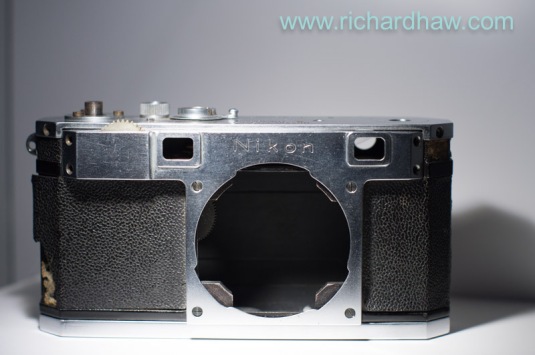 The journey starts with this prototype of the Nikon I. It is basically a copy of the popular Contax rangefinder camera that has been out for more than a decade before this camera was conceived. It merged the innovative Contax body and the reliable cloth shutter of the Leica rangefinder cameras. Notice that it has a shorter rangefinder base, a small decision that made a big impact when shooting with the camera as your finger will not cover the rangefinder window by accident. You trade-in accuracy for usability and for most cases, this small detail change meant the difference between getting the shot or missing it. Also notice that the lens mount and internal mechanism is missing.
The journey starts with this prototype of the Nikon I. It is basically a copy of the popular Contax rangefinder camera that has been out for more than a decade before this camera was conceived. It merged the innovative Contax body and the reliable cloth shutter of the Leica rangefinder cameras. Notice that it has a shorter rangefinder base, a small decision that made a big impact when shooting with the camera as your finger will not cover the rangefinder window by accident. You trade-in accuracy for usability and for most cases, this small detail change meant the difference between getting the shot or missing it. Also notice that the lens mount and internal mechanism is missing.
 Here is this venerable prototype’s story. To a Nikon aficionado like me, this empty hull of the camera that it once was made me a bit emotional. As somebody who fixes lenses and cameras (occasionally), I would say that this camera connected to me the most. It is as if I felt the people who made this camera talking to me, whispering “thank you” for giving it some kind of recognition and appreciating/understanding what they have done with this prototype. OK, maybe the hay fever medication is making me high again.
Here is this venerable prototype’s story. To a Nikon aficionado like me, this empty hull of the camera that it once was made me a bit emotional. As somebody who fixes lenses and cameras (occasionally), I would say that this camera connected to me the most. It is as if I felt the people who made this camera talking to me, whispering “thank you” for giving it some kind of recognition and appreciating/understanding what they have done with this prototype. OK, maybe the hay fever medication is making me high again.
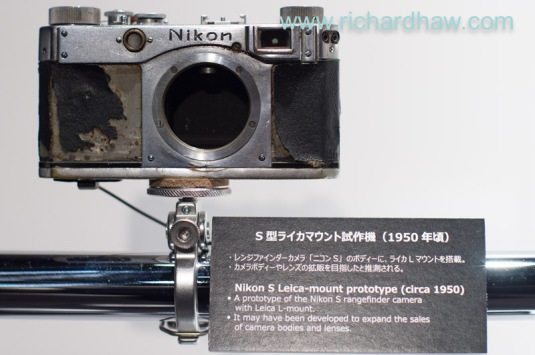 Now, this would have been an interesting camera if it was mass produced. I have an L39 fit Nikkor lens here and this made me wish that this went into production.
Now, this would have been an interesting camera if it was mass produced. I have an L39 fit Nikkor lens here and this made me wish that this went into production.
 The Nikon S3 is supposed to be the cheaper alternative to the Nikon SP. The Nikon SP was the most advanced rangefinder camera in it’s day because of the awesome viewfinder. It was expensive and complicated to manufacture as a result so the Nikon S3 was made to deal with this problem. Notice that the prototype had a different viewfinder from the full production model of the Nikon S3.
The Nikon S3 is supposed to be the cheaper alternative to the Nikon SP. The Nikon SP was the most advanced rangefinder camera in it’s day because of the awesome viewfinder. It was expensive and complicated to manufacture as a result so the Nikon S3 was made to deal with this problem. Notice that the prototype had a different viewfinder from the full production model of the Nikon S3.
The Rise of the SLR, All Hail the King:
With Nikon’s rangefinder cameras selling very well due their reputation of reliability and toughness but according to more recent sources, Nikon was developing an SLR alongside the Nikon SP and to cut cost both camera will need to share as many parts as possible. It’s a clever move because both cameras will mutually benefit from a single production line and this means more profits for the company. This dark twin of the Nikon SP is no more than the venerable Nikon F SLR camera.
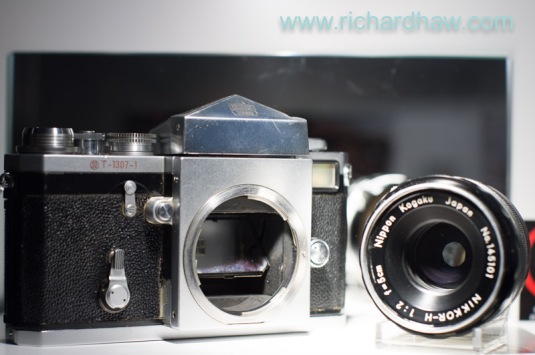 The next camera is the prototype for the Nikon F, the legendary camera that would make Nikon the dominant camera company. The legendary Nikon F is the sole camera that was responsible for making the SLR camera the dominant camera format in the coming years up until the present when the mirrorless cameras came to challenge the status quo.
The next camera is the prototype for the Nikon F, the legendary camera that would make Nikon the dominant camera company. The legendary Nikon F is the sole camera that was responsible for making the SLR camera the dominant camera format in the coming years up until the present when the mirrorless cameras came to challenge the status quo.
It is true that there were many SLR cameras that came before like the Asahiflex and the Zunow but the Nikon F is definitely the best handling of the lot and it’s reliability was the key to it’s success. As somebody who see and work on junk camera equipment, I will tell you that you can find Nikon Fs that were made in 1959 that still has a perfectly working shutter mechanism even of the camera has been badly stored. If there is an AK-47 for the cameras, this is the one. With more than 862,600 units (officially) made, this camera can claim to be one of the best-selling cameras in history.
 Notice that the prototype had a contour finder built-in to the body. This clever idea was dropped during production because simplicity means reliability (and also higher profits). Also notice that the lens mount is totally different, we are so used to seeing the Nikon F with the venerable F-mount (Fuketa mount). Check out the prototype lens,too!
Notice that the prototype had a contour finder built-in to the body. This clever idea was dropped during production because simplicity means reliability (and also higher profits). Also notice that the lens mount is totally different, we are so used to seeing the Nikon F with the venerable F-mount (Fuketa mount). Check out the prototype lens,too!
(click to enlarge)
Here are some more shots from my iPhone on how the contour finder works. Notice that the rewind crank has the same by-pass mechanism as that from the Nikon SP so that it’ll accommodate the extra stuff for the tiny window. These are worth reading.
 This late prototype is looking very much like the production model of the Nikon F. Notice that the silhouette has been greatly refined and simplified. The engineers were inspired by Bauhaus philosophy and 3 simple shapes were combined to form the silhouette of the camera – square, triangle and circle. This combination will stay for the decades to come as the de facto silhouette of the SLR.
This late prototype is looking very much like the production model of the Nikon F. Notice that the silhouette has been greatly refined and simplified. The engineers were inspired by Bauhaus philosophy and 3 simple shapes were combined to form the silhouette of the camera – square, triangle and circle. This combination will stay for the decades to come as the de facto silhouette of the SLR.
 Nikon also developed a half-frame version of the Nikon F. This format was practical for a number of purposes, mainly for portability (the Olympus Pen F), sports, policing and the military. Just imagine using a motor drive with this thing!
Nikon also developed a half-frame version of the Nikon F. This format was practical for a number of purposes, mainly for portability (the Olympus Pen F), sports, policing and the military. Just imagine using a motor drive with this thing!
The Last Breath for Nikon Rangefinders:
Now that the genie (Nikon F) has gotten out of the bottle, demand for the rangefinders of Nikon (and everybody else) dropped sharply. There really was no incentive for Nikon to further develop their rangefinder line since the SLR made it largely obsolete but there is still a segment of people who still have passion for Nikon rangefinders and Nikon might want to maintain a market share in the rangefinder business so development went on.
It is awesome to think that if the prototypes in this section went into full production then these would probably be the most advanced rangefinders of their time! However, things will not change and these cameras would remain only as prototypes. Read on.
 Now, this is what I call innovation! I am interested to see how that rewind mechanism is fitted to this prototype but I am not allowed to step beyond the line. It also has a complex parallax-correction system. This is probably why it didn’t saw production.
Now, this is what I call innovation! I am interested to see how that rewind mechanism is fitted to this prototype but I am not allowed to step beyond the line. It also has a complex parallax-correction system. This is probably why it didn’t saw production.
 These would have been amazing if they were sold. Imagine, having a zoom finder in one of your rangefinder cameras! This would have been very useful for telephoto lenses like the 13.5cm line of lenses. It is also greats because your viewfinder not cluttered with all those frame lines unlike that of the Nikon SP. This is the closest that we can get to having a real Nikon SP2.
These would have been amazing if they were sold. Imagine, having a zoom finder in one of your rangefinder cameras! This would have been very useful for telephoto lenses like the 13.5cm line of lenses. It is also greats because your viewfinder not cluttered with all those frame lines unlike that of the Nikon SP. This is the closest that we can get to having a real Nikon SP2.
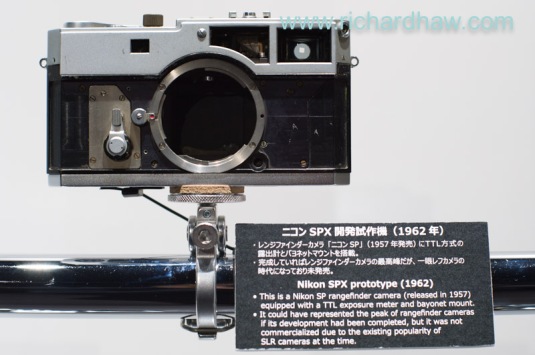 If this camera went into production, this would have given Leica another black-eye or it would have driven it out of business! That TTL metering gimmick is 9 years ahead of it’s time because the Leica M5 is the first Leica camera with TTL metering and it came out in 1971. It is also interesting that it came with a bayonet mount.
If this camera went into production, this would have given Leica another black-eye or it would have driven it out of business! That TTL metering gimmick is 9 years ahead of it’s time because the Leica M5 is the first Leica camera with TTL metering and it came out in 1971. It is also interesting that it came with a bayonet mount.
Legacy of the King (Golden Age):
With SLR sales showing no side of going down, it is but natural to expand on the product line and a few more models were added into it and that includes a replacement for the now aging Nikon F camera – the Nikon F2.
 I love Nikkormats (Nikomat here in Japan) because they are a joy to shoot with due to the of the exposure meter window found on top of the camera. I can now check my exposure without the need to peek into the viewfinder. Notice that the light meter was installed on the exterior on this prototype. It may have been used as a “proof of concept” for the body and the complicated shutter dial mechanism on the base of the mount. I hate fixing the Nikkormat FT cameras because of the complicated shutter selection mechanism and the overly-complicated viewfinder. A big price to pay for the joy of using and owning one for cheap since I got all of my Nikkormats as junk cameras.
I love Nikkormats (Nikomat here in Japan) because they are a joy to shoot with due to the of the exposure meter window found on top of the camera. I can now check my exposure without the need to peek into the viewfinder. Notice that the light meter was installed on the exterior on this prototype. It may have been used as a “proof of concept” for the body and the complicated shutter dial mechanism on the base of the mount. I hate fixing the Nikkormat FT cameras because of the complicated shutter selection mechanism and the overly-complicated viewfinder. A big price to pay for the joy of using and owning one for cheap since I got all of my Nikkormats as junk cameras.
 Here is the prototype of one of my favourite cameras, the Nikkormat EL. The prototype is very similar to the production model.
Here is the prototype of one of my favourite cameras, the Nikkormat EL. The prototype is very similar to the production model.
 The Nikon F was a best-seller for the company so it made no sense to disconnect from the design too much. The Nikon F2 is just an evolution of the Nikon F but the changes made to the design were significant; it modernised the Nikon F design.
The Nikon F was a best-seller for the company so it made no sense to disconnect from the design too much. The Nikon F2 is just an evolution of the Nikon F but the changes made to the design were significant; it modernised the Nikon F design.
 Here is another prototype of the Nikon F2, this time with a photomic head. This one looks a lot like the production model except for a few details written on the card.
Here is another prototype of the Nikon F2, this time with a photomic head. This one looks a lot like the production model except for a few details written on the card.
 An interesting prototype of the EE (Electronic Eye) system for the Nikon F2. This may be just a dummy for all we know. The production variant is just as bulky.
An interesting prototype of the EE (Electronic Eye) system for the Nikon F2. This may be just a dummy for all we know. The production variant is just as bulky.
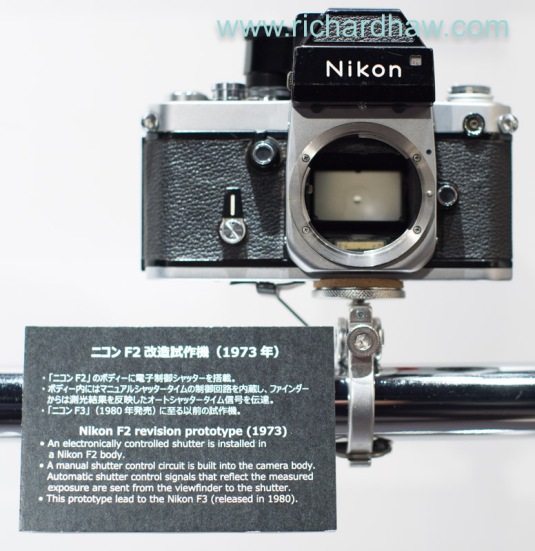 A very interesting and significant prototype! This is a true glimpse to the future and what is going to be considered Nikon’s future tech at the time, the legendary Nikon F3!
A very interesting and significant prototype! This is a true glimpse to the future and what is going to be considered Nikon’s future tech at the time, the legendary Nikon F3!
Dawn of a new era (Electronics):
Electronics was a big thing back in the ’80s as I recall and while there were many people who didn’t accept it initially, there was no stopping it from being implemented into our daily lives and this includes the things that we use like the camera.
This section of the exhibit shows Nikon’s foray into adding electronics to their cameras and the exciting evolution of SLR cameras from the late 1970s through the 1980s where electronics made many things possible for the SLR. Mechanical design and engineering reached it’s zenith in the late ’70s and electronics will take things even further.
 These prototypes are almost identical to the production cameras. I suspect that these two cameras were made to test the materials that they will eventually use and for finalising any problems with the electronics inside. The Nikon EM uses a polycarbonate body like that of the Canon AE-1. If Canon can get away with using plastic, surely Nikon can,too!
These prototypes are almost identical to the production cameras. I suspect that these two cameras were made to test the materials that they will eventually use and for finalising any problems with the electronics inside. The Nikon EM uses a polycarbonate body like that of the Canon AE-1. If Canon can get away with using plastic, surely Nikon can,too!
 The Nikon MDX. This camera is a testbed for the cameras that would in later during the ’80s like the F-301 and F-501 series of cameras. It resembled nothing in Nikon’s lineup so I would consider this to be a very important prototype.
The Nikon MDX. This camera is a testbed for the cameras that would in later during the ’80s like the F-301 and F-501 series of cameras. It resembled nothing in Nikon’s lineup so I would consider this to be a very important prototype.
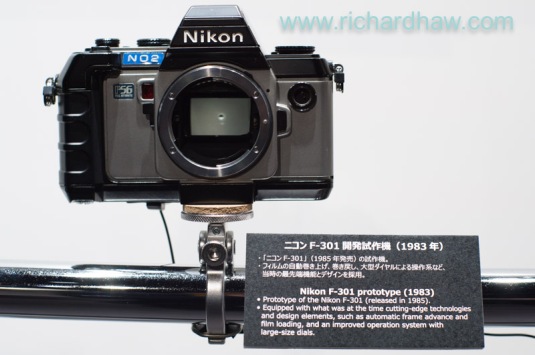 This prototype Nikon F-301 resembles the production model save for a few minor details like the height of the top-left panel. Notice that the grip is different as well as the position of the tripod socket.
This prototype Nikon F-301 resembles the production model save for a few minor details like the height of the top-left panel. Notice that the grip is different as well as the position of the tripod socket.
 Now, here is a late prototype for the Nikon F-301. Again, this is probably made to test out the materials that Nikon is going to eventually use for production.
Now, here is a late prototype for the Nikon F-301. Again, this is probably made to test out the materials that Nikon is going to eventually use for production.
The Last Great Manual Camera:
 Here is a description of the early development stages of what is to become the Nikon F3.
Here is a description of the early development stages of what is to become the Nikon F3.
 Here is an early prototype of the Nikon F3. Notice that the shape and format is different from the production model. It actually reminds me of the original Nikon FM camera. You can also see some electronic bits hanging outside the camera. Amazing how the general foundation for the Nikon F3 was already laid out this early.
Here is an early prototype of the Nikon F3. Notice that the shape and format is different from the production model. It actually reminds me of the original Nikon FM camera. You can also see some electronic bits hanging outside the camera. Amazing how the general foundation for the Nikon F3 was already laid out this early.
 Another prototype but this time the electronic bits were not exposed anymore.
Another prototype but this time the electronic bits were not exposed anymore.
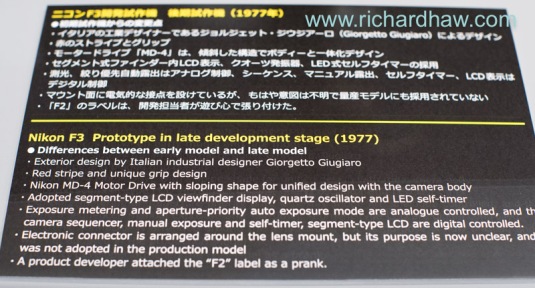 A very interesting outline of what this display is about.
A very interesting outline of what this display is about.
 Here is the Nikon F3 after it received a facelift from Giorgetto Giugiaro. Giugiaro added a red stripe to the Nikon F3 because he designed Ferrari supercars. It gave the Nikon F3 a little bit of sex appeal and all Nikon cameras ever since inherited this red accent. Notice the “F2” labels on the prototype, these were stuck there as some sort of gag by one of the engineers. The Nikon F3 is also the first Nikon SLR to have a grip of some sort. Nikon did the right thing by having Giugiaro design it’s cameras, this was something that was never done before in the camera industry. This is one of the reasons why the Nikon F3 felt good in my hands and is so intuitive to use. I love the Nikon F3, it is a masterpiece!
Here is the Nikon F3 after it received a facelift from Giorgetto Giugiaro. Giugiaro added a red stripe to the Nikon F3 because he designed Ferrari supercars. It gave the Nikon F3 a little bit of sex appeal and all Nikon cameras ever since inherited this red accent. Notice the “F2” labels on the prototype, these were stuck there as some sort of gag by one of the engineers. The Nikon F3 is also the first Nikon SLR to have a grip of some sort. Nikon did the right thing by having Giugiaro design it’s cameras, this was something that was never done before in the camera industry. This is one of the reasons why the Nikon F3 felt good in my hands and is so intuitive to use. I love the Nikon F3, it is a masterpiece!
 A brief description of the Nikon F3’s electronics display.
A brief description of the Nikon F3’s electronics display.
 Here is one of the prototypes for the electronic substrate/harness. The bulb-like thing on the top of the picture is the light sensor for TTL metering while that long thing atop that is the LCD display assembly. Many Nikon F3s today have bleeding LCD because of age.
Here is one of the prototypes for the electronic substrate/harness. The bulb-like thing on the top of the picture is the light sensor for TTL metering while that long thing atop that is the LCD display assembly. Many Nikon F3s today have bleeding LCD because of age.
 Here is another one and it looks more complicated than the previous one.
Here is another one and it looks more complicated than the previous one.
 The part on the lower right of the picture looks like the part that connects to the shutter speed FRE. That maroon part on top looks like the one in the rewind lever and it seems like the ISO speed FRE is also there. This is from the production model by the way.
The part on the lower right of the picture looks like the part that connects to the shutter speed FRE. That maroon part on top looks like the one in the rewind lever and it seems like the ISO speed FRE is also there. This is from the production model by the way.
Linking the Past with the Future:
Very few camera companies can boast of such an extensive lineup of lenses that spans a couple of decades. The fact that you can use F-mount lenses made during the early 1960s to the present on some of Nikon’s cameras with little to no modifications says a lot. Nikon was transitioning from an all-manual lens line-up to autofocus lenses in the mid ’80s and the solution was to modify the existing F-mount for backwards compatibility instead of designing a new lens mount and abandoning the long line of Nikkors. Interestingly, this technology was first implemented on a consumer SLR and not on a flagship model. Nikon introduced the Nikon F4 to replace the Nikon F3 and the improvements were huge! I can say that the Nikon F4 brought Nikon’s camera technology to another level. Not only did it autofocus (but a bit slow), it had great metering, auto-rewind/advance, removable grips that you can use to customise the body and some other things that were never seen on a Nikon SLR before it. The camera is another masterpiece and was a technical wonder of a camera when viewed from an engineering perspective. It is one of the most convoluted cameras ever made and is notorious in the camera repair circle as a difficult camera to take apart due to the numerous interlocking parts. This was necessary because this was what the technology of the ’80s can offer at the time.
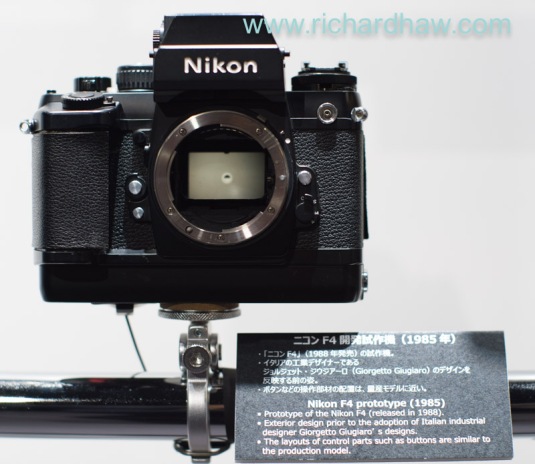 Just look at this beauty! I love how angular it looks, very masculine! The Nikon F4 would serve as the template from which successive Nikon film SLRs will be base on and many of it’s influences carry on to the present. This is a very important camera, a real classic.
Just look at this beauty! I love how angular it looks, very masculine! The Nikon F4 would serve as the template from which successive Nikon film SLRs will be base on and many of it’s influences carry on to the present. This is a very important camera, a real classic.
 After being redesigned by Giugiaro, this prototype now resembles the Nikon F4 everyone is familiar with. Notice that it is missing the engraved name an some minor details that are present in the production model.
After being redesigned by Giugiaro, this prototype now resembles the Nikon F4 everyone is familiar with. Notice that it is missing the engraved name an some minor details that are present in the production model.
Conclusion:
Whew! This took me several nights to finish so I hope that you enjoyed the pictures and my accompanying commentaries! This article will be updated in the near future because I will be going back to the Nikon Museum next week and if I find anything new, I will add it to this blog post. I will be talking to some of the people involved in the development of some of the cameras here and I will ask relevant questions and share the answers to all of you. The next successive parts will be added until we are done with Nikon’s 100th year anniversary. Don’t worry, I am your field reporter so you will not be missing a lot! I was telling one of my readers about how much effort I put in this blog but that is OK, so long as you are enjoying it and also for posterity’s sake. If you ever find any mistakes, please tell me so I can fix it ASAP. I am still in my hay fever medication and a shot of Tanqueray gin doesn’t help at all, it actually made me even more drowsy.
Thank you very much for your time and I hope that you’ve enjoyed this. Please share this article if you enjoyed it, I certainly need the added boost in site traffic. We are currently hitting around 12K hits a month and I am hoping that we can have more than that in the near future! See you again next week! Love, Ric.
PS: Thanks to John and Peter for helping me correct some of the information presented in this article!
Help Support this Blog:
Maintaining this blog requires money to operate. If you think that this site has helped you or you want to show your support by helping with the upkeep of this site, you can simple make a small donation to my paypal.com account (richardHaw888@gmail.com). Money is not my prime motivation for this blog and I believe that I have enough to run this but you can help me make this site (and the companion facebook page) grow.
Helping support this site will ensure that this will be kept going as long as I have the time and energy for this. I would appreciate it if you just leave out your name or details like your country and other information so that the donations will totally be anonymous it is at all possible. This is a labor of love and I intend to keep it that way for as long as I can. Ric.






Apr 16, 2017 @ 20:18:48
Thank you!
May 19, 2017 @ 10:04:02
Grand synthesis! Thank you
May 21, 2017 @ 13:57:30
Thanks!!!
Apr 09, 2022 @ 12:21:51
Hi, I really enjoyed your site as a Nikon collector, and now in my eighties. Working
as a photographer I assembled a Nikon collectors product library. if this is of any use to you. Cheers Tony